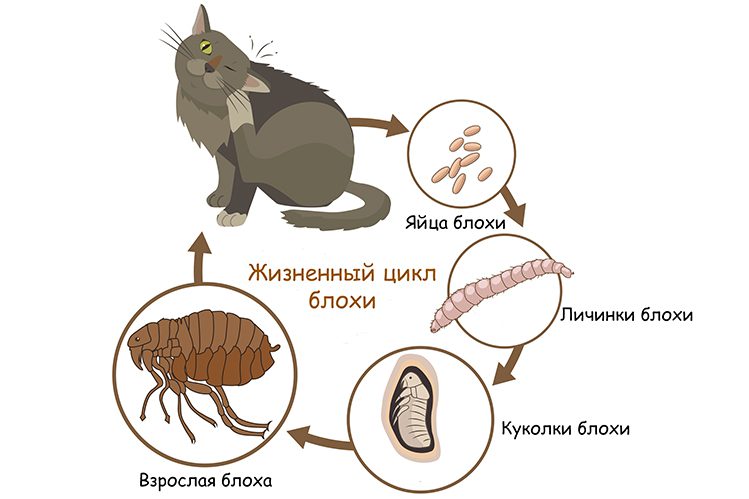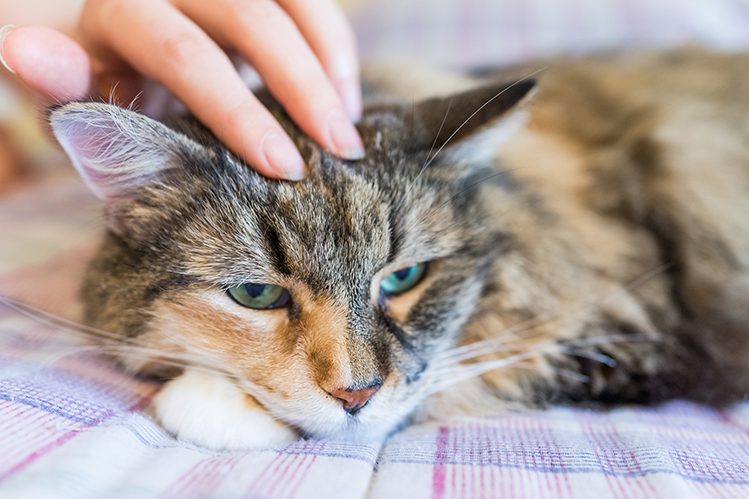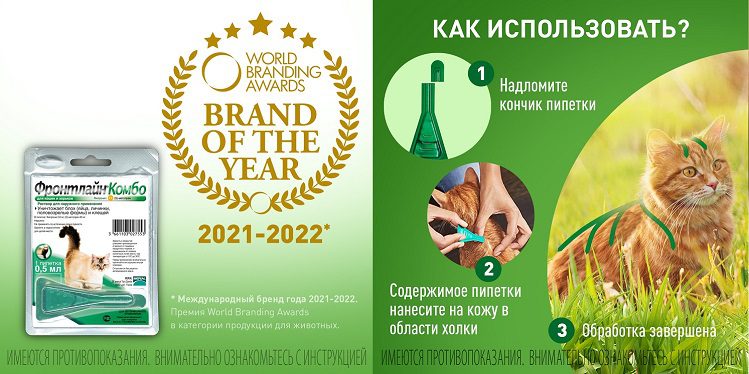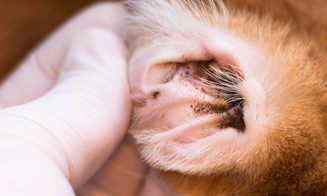
How to treat a cat for fleas and ticks
Fleas are the most common external parasites of cats. If you let your pet go outside without antiparasitic treatment, it is 100% likely that he has fleas. But what about cats that never leave the apartment? Can a domestic cat get fleas? And what about ticks – are they dangerous for cats? Let’s talk about the treatment of cats from fleas and ticks in our article.
Contents
At what time of the year can you get fleas?
Unlike ticks, which fall asleep at least in cold weather, fleas are active all year round. They live not only on the street, but also in the basements of residential buildings, and in the entrances, they are carried by other animals.
In the winter months, the risk of encountering fleas increases near basements and heating mains: parasites are hardy, but thermophilic. And, of course, the dream of every flea is to move into a warm apartment with pets. There she can quickly create a huge colony of her relatives.
Just imagine: one sexually mature flea lays over 40 eggs daily. These eggs hatch into larvae. They hide in secluded corners of the apartment: in crevices, behind baseboards, in furniture, in folds of linen, in carpets, in bedding and in the pet’s house.

Can fleas get on a cat that never goes outside?
Fleas can appear in a cat that has never been outside and has never been in contact with other pets. Moreover, this happens frequently. A well-groomed cat lives calmly and happily, and suddenly, all of a sudden, fleas appear in her. How could they get into the house?
- Fleas could be brought in from the street by your dog.
- Fleas can get into the apartment through the door or cracks from the entrance, basement.
- And perhaps you yourself will bring fleas into the apartment: on your clothes or shoes, without even knowing it.
Such a guest will not remain unnoticed for long. In good conditions, parasites multiply at a staggering rate, and in just a couple of days you will inevitably suspect their presence.
A cat infected with fleas begins to itch and “bite” the skin with its teeth in an attempt to catch the tormentor. If you notice these symptoms, carefully examine your pet. Arm yourself with a comb or push the hair straight with your hands. Examine the whole body. You will most likely see an adult parasite almost immediately. Also a hint are black crumbs on the skin – these are flea excrement.

How to remove fleas from a cat?
If the cat is dirty, the first thing to do is bathe it. If not, go straight to flea treatment.
- We bathe the cat
Wash your pet with a special anti-parasitic shampoo. It should suit your cat. Carefully read the purpose and follow the instructions for use, otherwise there will be no effect.
Anti-flea shampoos help to destroy some of the parasites, but, unfortunately, they do not guarantee a 100% effect and do not provide further protection. After washing, a more serious treatment is carried out, which gives a lasting effect.
Flea treatment is carried out 48 hours before bathing or 48 hours after it. Carefully read the instructions for the tool.
- Flea treatment
Treat your cat for fleas 2 days after bathing. There are a lot of means of protection: these are sprays, drops on the withers (“Frontline Combo”), collars (“Foresto”). It is enough to use one reliable tool for constant protection. Each drug has its own characteristics and recommendations for compatibility.
Before combining funds, be sure to consult a specialist, and carefully read the instructions before processing.
The most popular means of protection is drops on the withers (“Frontline Combo”). They are easy to use and the efficiency is very high. The pet will not be able to lick the drops from its withers. If you follow the instructions for use, the product is completely safe for cats.
It is important to correctly calculate the dosage of the drug. Determine the weight of the pet and follow the instructions. It is necessary to process not only the pet, but also its bed, furniture and carpets in the apartment. For this, an antiparasitic spray (“Frontline”) is suitable. It will destroy adult parasites and their larvae. Treat all cats and dogs in the house for fleas.

- We carry out deworming
Fleas carry helminth eggs. Therefore, an animal infected with fleas is likely to become infected with helminths. As soon as you cope with external parasites and the cat gets stronger, move on to the fight against internal ones! Be sure to deworm your pet so that nothing threatens his health.
How to protect a cat from fleas?
The guarantee of protection against fleas is a regular antiparasitic treatment. Read how long the remedy you have chosen works. As soon as the protection period begins to expire, repeat the processing.
Do not overdo it. In an attempt to protect a pet, many inexperienced owners begin to combine protective equipment: for example, they use both drops and a collar. This can be dangerous for the pet. One drug is enough. Read the instructions carefully.
Are ticks dangerous for cats?
Ixodid ticks are parasites that live in the environment and feed on the blood of mammals, including humans. In structure, hungry individuals are similar to spiders. But when the tick sticks to the victim and sucks in blood, its body swells and becomes like a large pea.
To meet with a tick, it is not necessary to travel to the forest. A cat can pick up a parasite while walking in the yard on a harness. Moreover, you can bring the tick into the apartment yourself on shoes or outerwear. The likelihood of a bite is maximized if you take your pet with you to the country. It is enough for a cat to simply run through the tall grass to collect not one or even two, but dozens of ticks!
The bite of a blood-sucking parasite is unpleasant in itself, but this is not the main thing. Ixodid ticks are potential carriers of blood-parasitic diseases, some of which lead to death if left untreated. Dogs can become infected from ticks with babesiosis (piroplasmosis), and for cats, hemobartonellosis is the most dangerous. If left untreated, the disease leads to oxygen starvation and subsequent death of the pet.

If you decide to take your cat for a walk or take it with you to the country, the first thing you should do is treat it for ticks in advance. How to do it and why in advance?
How to treat a cat from ticks?
In pet stores you will be offered a variety of antiparasitic agents: drops on the withers (“Frontline Combo”), collars (“Foresto”), sprays (“Frontline Spray”). Carefully study their description, method of application and period of validity and choose what is convenient for you. Before buying, it is advisable to read customer reviews and information about the brand. Do not forget to check the expiration date of the product, and when processing the animal, strictly follow the instructions for use.
After applying the drug, protection does not begin to act immediately. This usually takes 2-3 days, depending on the characteristics of the selected drug. For example, Frontline Combo tick drops are applied to the cat’s skin 2-3 days before departure. Antiparasitic collars (“Foresto”) should be put on the cat about 3-5 days before the trip. Spray treatment, for example, “Frontline”, is also carried out in a couple of days.
For a certain period of time before and after treatment, the pet should not be bathed. More about this in the instructions for using the selected tool.
In addition to processing, do not forget about the regular inspection of the pet. As soon as he returned from the street, carefully examine his skin and coat. Pay special attention to places where there is the least hair: auricles, muzzle, armpits and inguinal cavities. You may be able to detect parasites before the bite occurs.
Another measure of protection against ticks is mowing the lawn. Ticks readily breed in long grass, but are rarely found in short grass. Someone also treats lawns from parasites with special chemicals. However, they are unfortunately not safe for children and animals.
Be careful and do not forget that diseases are easier to prevent than to cure! Protect your pet!





